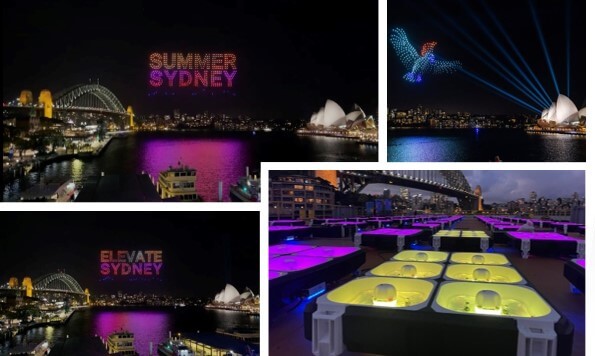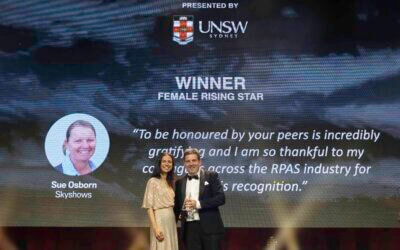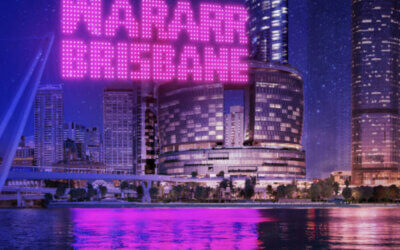An insight into what defines great Drone Light Shows
There has been a lot of hype in the past about the record number of drones to produce a good Drone Light Show (DLS). But there’s more important aspects of a DLS than the number of drones being used. There are many factors to consider when determining the ideal number of drones required. For example, if you want to provide a close intimate show, you might only require a small canvas (air space) to provide the right effect. Or you may be presented with a huge area, and an equally large audience to captivate and therefore this would require more drones to achieve the right effect.
So, it’s not about the numbers at all. The real difference in quality of a DLS comes from the creative designer and the technology that enables the right effect to be achieved. Let’s look at these two aspects in detail, starting with the creative.
The creative element of a DLS begins with the client’s idea; what their aim or purpose of the show is about. But getting that idea; to tell the story as intended; to captivate the audience; and provide a bespoke experience; takes a great deal of knowledge and skill and this is the difference between one show and another. But with these skills also comes cost, because to have the best show, with the best creative experts cost money. Let’s look at why.
The Creative Director of a DLS is the brains behind the scenes and the key to bespoke design and artwork. A good creator will seek out others to complement their ideas. This is what Anthony Bastic, of AGB Events, did when he designed the creative for ELEVATE Sydney 2022. Bastic sought out the experience and knowledge of First Nations advisor Rhonda Roberts AO, when he was planning the indigenous themes for this show. He wanted to ensure he was telling the story right, with the correct images authentic to the indigenous culture. The boomerang for example, in ELEVATE 22, was a specific type of boomerang pertinent to the Gadigal people, and therefore demonstrating the linkage to Sydney. This amount of intricate detail could not have been achieved had Bastic not invested time and effort into his creative artwork.
Some DLS providers seek to reduce costs to shows by reusing images from catalogues of past shows in a cookie cutting method to create new shows. This works from some shows, e.g., repetitive themes such as Halloween, Christmas, and the like. These shows can easily be made from reusing past images in a different order and colour to appear as a new show, making them cost effective and quick to produce.
Another important aspect to the creative is the animator. The animator is responsible for taking the creative director’s visions and completing the design work in the DLS software. A great animator knows how to get the best out of a system by designing transitions that complement the airspace available, especially when the space is small. Each drone path must be checked to ensure they don’t collide mid transition and therefore creating holes in the show. The animator will use tools such as a simulator to show the creative team how the show is progressing and together make the necessary adjustments until its perfect.
The other part I’d like to talk about is the technology; meaning the software and/or hardware being used for the show. A lot of companies are using the Universal Drone Show Software (DSS) to enable their shows, while other companies understand its shortfalls and have created their own software. We all know software giant Intel ™ as one of the leaders in this space. Their software is purpose made for their Shooting Star® hardware and has seen over 1000 shows delivered across the world and in some of the most high-profile settings such as the Olympics and Superbowl. Likewise, has the new up and coming company Verve Aero, who has also designed its own hardware and software which enabled them to deliver an amazing show on TV show “America’s Got Talent”.
You see the difference in software and hardware defines how close the drones can get to one another and therefore creates a tighter image which looks better. It’s kind of like pixels on a tv. This is again important in those tight knit environments that don’t have an endless horizon to spread out in. The size/weight of the drones also helps as the smaller ones can get closer as they produce less recirculation of air reducing the likelihood of a mid-air collision. One more factor with weight is the drone’s ability to float if presenting a show over water. This is another area Intel™ have excelled in, as their Shooting Star® drones float on water making them an ideal choice for shows in Sydney Harbour, because let’s face it no-one wants rotting LiPo batteries at the bottom of our waterways.
Which brings me to my final aspect, batteries. Most drone systems still require the tedious task of manual battery changes between shows which can restrict the ability to conduct multiple shows each night . Wouldn’t it be great to deliver a show early for families and young children and then another show an hour or so later, for those looking for a late night out.
So, if you are looking for a DLS for your next festival or event, be sure to investigate what you are getting from a creative and technology aspect to ensure it meets your budget and needs as well as being a proven system amongst our leading aviation regulators.




